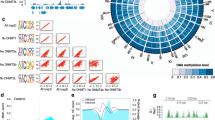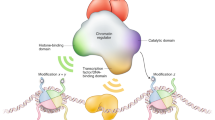Abstract
Histones of multicellular organisms are assembled into chromatin primarily during DNA replication. When chromatin assembly occurs at other times, the histone H3.3 variant replaces canonical H3. Here we introduce a new strategy for profiling epigenetic patterns on the basis of H3.3 replacement, using microarrays covering roughly one-third of the Drosophila melanogaster genome at 100-bp resolution. We identified patterns of H3.3 replacement over active genes and transposons. H3.3 replacement occurred prominently at sites of abundant RNA polymerase II and methylated H3 Lys4 throughout the genome and was enhanced on the dosage-compensated male X chromosome. Active genes were depleted of histones at promoters and were enriched in H3.3 from upstream to downstream of transcription units. We propose that deposition and inheritance of actively modified H3.3 in regulatory regions maintains transcriptionally active chromatin.
This is a preview of subscription content, access via your institution
Access options
Subscribe to this journal
Receive 12 print issues and online access
$209.00 per year
only $17.42 per issue
Buy this article
- Purchase on Springer Link
- Instant access to full article PDF
Prices may be subject to local taxes which are calculated during checkout






Similar content being viewed by others
Accession codes
References
Wolffe, A.P. Chromatin: Structure and Function (Academic, San Diego, 1992).
Ringrose, L. & Paro, R. Epigenetic regulation of cellular memory by the Polycomb and Trithorax group proteins. Annu. Rev. Genet. 38, 413–443 (2004).
Schubeler, D. et al. The histone modification pattern of active genes revealed through genome-wide chromatin analysis of a higher eukaryote. Genes Dev. 18, 1263–1271 (2004).
Bernstein, B.E. et al. Genomic maps and comparative analysis of histone modifications in human and mouse. Cell 120, 169–181 (2005).
Kurdistani, S.K., Tavazoie, S. & Grunstein, M. Mapping global histone acetylation patterns to gene expression. Cell 117, 721–733 (2004).
Ahmad, K. & Henikoff, S. The histone variant H3.3 marks active chromatin by replication-independent nucleosome assembly. Mol. Cell 9, 1191–1200 (2002).
Tagami, H., Ray-Gallet, D., Almouzni, G. & Nakatani, Y. Histone H3.1 and H3.3 complexes mediate nucleosome assembly pathways dependent or independent of DNA synthesis. Cell 116, 51–61 (2004).
Janicki, S.M. et al. From silencing to gene expression: Real-time analysis in single cells. Cell 116, 683–698 (2004).
Schwartz, B.E. & Ahmad, K. Transcriptional activation triggers deposition and removal of the histone variant H3.3. Genes Dev. 19, 804–814 (2005).
Chow, C.M. et al. Variant histone H3.3 marks promoters of transcriptionally active genes during mammalian cell division. EMBO Rep. 6, 354–360 (2005).
McKittrick, E., Gafken, P.R., Ahmad, K. & Henikoff, S. Histone H3.3 is enriched in covalent modifications associated with active chromatin. Proc. Natl. Acad. Sci. USA 101, 1525–1530 (2004).
Waterborg, J.H. Sequence analysis of acetylation and methylation in two histone H3 variants of alfalfa. J. Biol. Chem. 265, 17157–17161 (1990).
Johnson, L. et al. Mass spectrometry analysis of Arabidopsis histone H3 reveals distinct combinations of post-translational modifications. Nucleic Acids Res. 32, 6511–6518 (2004).
de Boer, E. et al. Efficient biotinylation and single-step purification of tagged transcription factors in mammalian cells and transgenic mice. Proc. Natl. Acad. Sci. USA 100, 7480–7485 (2003).
MacAlpine, D.M., Rodriguez, H.K. & Bell, S.P. Coordination of replication and transcription along a Drosophila chromosome. Genes Dev. 18, 3094–3105 (2004).
Martens, J.H. et al. The profile of repeat-associated histone lysine methylation states in the mouse epigenome. EMBO J. 24, 800–812 (2005).
Bernstein, B.E., Liu, C.L., Humphrey, E.L., Perlstein, E.O. & Schreiber, S.L. Global nucleosome occupancy in yeast. Genome Biol. 5, R62 (2004).
Lee, C.K., Shibata, Y., Rao, B., Strahl, B.D. & Lieb, J.D. Evidence for nucleosome depletion at active regulatory regions genome-wide. Nat. Genet. 36, 900–905 (2004).
Ahmad, K. & Henikoff, S. Centromeres are specialized replication domains in heterochromatin. J. Cell Biol. 153, 101–110 (2001).
Schwabish, M.A. & Struhl, K. Evidence for eviction and rapid deposition of histones upon transcriptional elongation by RNA polymerase II. Mol. Cell. Biol. 24, 10111–10117 (2004).
Kristjuhan, A. & Svejstrup, J.Q. Evidence for distinct mechanisms facilitating transcript elongation through chromatin in vivo . EMBO J. 23, 4243–4252 (2004).
Boeger, H., Griesenbeck, J., Strattan, J.S. & Kornberg, R.D. Nucleosomes unfold completely at a transcriptionally active promoter. Mol. Cell 11, 1587–1598 (2003).
Reinke, H. & Horz, W. Histones are first hyperacetylated and then lose contact with the activated PHO5 promoter. Mol. Cell 11, 1599–1607 (2003).
Yuan, G.C. et al. Genome-scale identification of nucleosome positions in S. cerevisiae . Science 309, 626–630 (2005).
Workman, J.L. & Abmayr, S.M. Histone H3 variants and modifications on transcribed genes. Proc. Natl. Acad. Sci. USA 101, 1429–1430 (2004).
Henikoff, S., Furuyama, T. & Ahmad, A. Histone variants, nucleosome assembly and epigenetic inheritance. Trends Genet. 20, 320–326 (2004).
Henikoff, S. & Meneely, P. Unwinding dosage compensation. Cell 72, 1–2 (1993).
Smith, E.R., Allis, C.D. & Lucchesi, J.C. Linking global histone acetylation to the transcription enhancement of X-chromosomal genes in Drosophila males. J. Biol. Chem. 276, 31483–31486 (2001).
Straub, T., Dahlsveen, I.K. & Becker, P.B. Dosage compensation in flies: Mechanism, models, mystery. FEBS Lett. 579, 3258–3263 (2005).
Copps, K. et al. Complex formation by the Drosophila MSL proteins: role of the MSL2 RING finger in protein complex assembly. EMBO J. 17, 5409–5417 (1998).
Roh, T.Y., Ngau, W.C., Cui, K., Landsman, D. & Zhao, K. High-resolution genome-wide mapping of histone modifications. Nat. Biotechnol. 22, 1013–1016 (2004).
van Steensel, B. Mapping of genetic and epigenetic regulatory networks using microarrays. Nat. Genet. 37 Suppl, S18–S24 (2005).
Kirmizis, A. et al. Silencing of human polycomb target genes is associated with methylation of histone H3 Lys 27. Genes Dev. 18, 1592–1605 (2004).
Sarraf, S.A. & Stancheva, I. Methyl-CpG binding protein MBD1 couples histone H3 methylation at lysine 9 by SETDB1 to DNA replication and chromatin assembly. Mol. Cell 15, 595–605 (2004).
Tyler, J.K. et al. The RCAF complex mediates chromatin assembly during DNA replication and repair. Nature 402, 555–560 (1999).
Thiriet, C. & Hayes, J.J. Replication-independent core histone dynamics at transcriptionally active loci in vivo . Genes Dev. 19, 677–682 (2005).
Gribnau, J., Diderich, K., Pruzina, S., Calzolari, R. & Fraser, P. Intergenic transcription and developmental remodeling of chromatin subdomains in the human β-globin locus. Mol. Cell 5, 377–386 (2000).
Lipshitz, H.D., Peattie, D.A. & Hogness, D.S. Novel transcripts from the Ultrabithorax domain of the bithorax complex. Genes Dev. 1, 307–322 (1987).
Wyers, F. et al. Cryptic Pol II transcripts are degraded by a nuclear quality control pathway involving a new poly(A) polymerase. Cell 121, 725–737 (2005).
Johnson, J.M., Edwards, S., Shoemaker, D. & Schadt, E.E. Dark matter in the genome: evidence of widespread transcription detected by microarray tiling experiments. Trends Genet. 21, 93–102 (2005).
Hogga, I. & Karch, F. Transcription through the iab-7 cis-regulatory domain of the bithorax complex interferes with maintenance of Polycomb-mediated silencing. Development 129, 4915–4922 (2002).
Rank, G., Prestel, M. & Paro, R. Transcription through intergenic chromosomal memory elements of the Drosophila bithorax complex correlates with an epigenetic switch. Mol. Cell. Biol. 22, 8026–8034 (2002).
Schmitt, S., Prestel, M. & Paro, R. Intergenic transcription through a polycomb group response element counteracts silencing. Genes Dev. 19, 697–708 (2005).
Bunch, T.A., Grinblat, Y. & Goldstein, L.S. Characterization and use of the Drosophila metallothionein promoter in cultured Drosophila melanogaster cells. Nucleic Acids Res. 16, 1043–1061 (1988).
Beckett, D., Kovaleva, E. & Schatz, P.J. A minimal peptide substrate in biotin holoenzyme synthetase-catalyzed biotinylation. Protein Sci. 8, 921–929 (1999).
Iwaki, T., Figuera, M., Ploplis, V.A. & Castellino, F.J. Rapid selection of Drosophila S2 cells with the puromycin resistance gene. Biotechniques 35, 482–484, 486 (2003).
Echalier, G. Drosophila Cells in Culture (Academic, New York, 1997).
Henikoff, S., Ahmad, K., Platero, J.S. & van Steensel, B. Heterochromatic deposition of centromeric histone H3-like proteins. Proc. Natl. Acad. Sci. USA 97, 716–721 (2000).
Blower, M.D., Sullivan, B.A. & Karpen, G.H. Conserved organization of centromeric chromatin in flies and humans. Dev. Cell 2, 319–330 (2002).
Pollack, J.R. et al. Genome-wide analysis of DNA copy-number changes using cDNA microarrays. Nat. Genet. 23, 41–46 (1999).
Acknowledgements
We thank T. Furuyama for providing the biotin pull-down system and for advice in generating lines; Y. Dalal for advice on chromatin procedures; T. Iwaki for the puromycin resistance gene; J. Delrow, M. Aronszajn, L. Chow and K. Munn for help and advice; D. Schübeler for sharing unpublished information; J. Lucchesi for discussions of dosage compensation; and members of our laboratory for discussions and comments on the manuscript.
Author information
Authors and Affiliations
Corresponding author
Ethics declarations
Competing interests
The authors declare no competing financial interests.
Supplementary information
Supplementary Fig. 1
Scatterplots comparing signal ratios of H3.3core or H3 to signal ratios of individual modifications based on cDNA array analysis. (PDF 428 kb)
Supplementary Fig. 2
Transposon profiles for H3.3/H3 datasets. (PDF 63 kb)
Supplementary Fig. 3
Diagram of the method used for averaging genes and removing overlaps. (PDF 64 kb)
Supplementary Fig. 4
Enhancement of H3.3 replacement at genes on the male chromosome in S2 cells. (PDF 61 kb)
Supplementary Fig. 5
Typical growth curve for a stably transformed cell line, showing timing of induction and harvesting for chromatin affinity purification. (PDF 56 kb)
Supplementary Fig. 6
Western blot analyses of histones in cells and after extraction from nuclei. (PDF 361 kb)
Supplementary Fig. 7
MNase cleavage and pull-down of nucleosomes used for profiling. (PDF 126 kb)
Rights and permissions
About this article
Cite this article
Mito, Y., Henikoff, J. & Henikoff, S. Genome-scale profiling of histone H3.3 replacement patterns. Nat Genet 37, 1090–1097 (2005). https://doi.org/10.1038/ng1637
Received:
Accepted:
Published:
Issue Date:
DOI: https://doi.org/10.1038/ng1637
This article is cited by
-
Differential effect of histone H3.3 depletion on retroviral repression in embryonic stem cells
Clinical Epigenetics (2023)
-
Dynamic changes in whole genome DNA methylation, chromatin and gene expression during mouse lens differentiation
Epigenetics & Chromatin (2023)
-
H3.3 contributes to chromatin accessibility and transcription factor binding at promoter-proximal regulatory elements in embryonic stem cells
Genome Biology (2023)
-
Histone chaperone ASF1 mediates H3.3-H4 deposition in Arabidopsis
Nature Communications (2022)
-
H2A.Z acetylation by lincZNF337-AS1 via KAT5 implicated in the transcriptional misregulation in cancer signaling pathway in hepatocellular carcinoma
Cell Death & Disease (2021)



